Preprint
Article
Uncovering Urban Palimpsest through Descriptive and Ana-Lytical Approaches to Urban Morphology. Understanding the Ottoman Urban Fabric of Bursa, Türkiye
Altmetrics
Downloads
96
Views
48
Comments
0
A peer-reviewed article of this preprint also exists.
This version is not peer-reviewed
Submitted:
26 July 2024
Posted:
29 July 2024
You are already at the latest version
Alerts
Abstract
This study investigates the structured spatial organization through a focus on streets, blocks and buildings, proposing them as fundamental components in conceptualizing cities as layered pal-impsests. Former Ottoman capital city, Bursa, serve as case study due to its rich evolutionary history and the potentiality of the urban heritage values/elements they demonstrate. Following the “Tanzimat” Era, a period marked by modernization and renewal, the urban fabric of Ottoman capital cities underwent significant reforms aimed at aligning them with the principles of mo-dernity. Maps dating back to the 19th century serve as the most illustrative sources for compre-hending the evolving character and layout of these cities. The foundational aspects of the charac-ter and appearance of the historic environment played crucial roles not only in shaping the mod-ern city but also in preserving and enhancing urban heritage areas by harmonizing them with contemporary urban conditions. Factors such as street age, street hierarchy, block typology, and the localization of historical landmarks are indispensable for grasping the developmental trajec-tory of these cities, offering insights that bridge spatial scales and span across historical eras. Employing a combination of qualitative and quantitative data, this research builds upon descrip-tive and analytical approaches to urban morphology. The methodology entails comprehensive morphological analysis, which involves assessing changes and persistence in the urban fabric of selected heritage site, both pre-existing and post-modernization, drawing from its historically scientific maps. The analysis focuses on abstracting key attributes such as type, configuration, size, and the relationship between the elements.
Keywords:
Subject: Engineering - Architecture, Building and Construction
1. Introduction
The urban fabric concept in urban morphology is determined by the evolution or changes in urban form and the relationships between urban fabric elements (streets, plots, squares, open spaces, and green spaces) [1] (p. 537). Patterns in the inherited urban landscape are the past of the urban fabric [2] (p. 8); some patterns remain constant, certain aspects are embedded in the urban fabric, and there are new ways of urban development [3] (p. 79). The urban fabric is evidence of retrospective value in the future and absorbs historical patterns.
Cities expose different transformations factors such as natural disasters or man-made actions, which create paradoxes in urban organization and complicate the legibility of inherited morphological elements within the contemporary urban fabric. From the morphological perspective, the urban fabric is extremely complex and multi-layered in contemporary cities. In this way, urban fabric act as palimpsest. In the case of layered/palimpsest cities, the analysis of urban fabric transformations focuses on specific topics: the tendency for changes, derivation or persistence of features (configuration), the degree of historical stratification between periods (size), the powerful constancy of relationships, and the distinctive residues of past periods (types).
The urban form in Bursa is representing the development of the first Ottoman city structure, and exhibits heterogeneous influences from the great empires that directly affected the city’s history. The narrow, and winding dead-end streets could no longer accommodate the demands of modernization, thus the urban reform and modernization efforts in the Ottoman reform era “Tanzimat” (1839-1876), the last Ottoman period, and during the post war republic era (1922-1960) have resulted in the loss of the integrity of the traditional Islamic urban fabric. During this period, major fires and earthquakes wiped out almost the entire historic core of Bursa, especially around the Khan area. This extensive damage led to the reconstruction of buildings and new planning decisions aimed at modernizing the city [4]. Consequently, the urban fabric in the Khan area has become a complex organism where patterns from the past and present coexist (formation and transformation).
The process of urban transformation is inherently complex, and understanding it requires a comprehensive approach. Such activities are crucial for obtaining information about all aspects of the elements in the historic environment, as explaining them helps to understand the essential mechanisms of cities. This necessitates tracing, describing, and revealing patterns through different time dimensions within the urban fabric to evaluate the levels of the transformation process. Position, outline, and internal arrangement are key principles used to describe the urban tissue and the evolution of types across different periods [5,6]. Therefore, examining the development of the urban fabric only through qualitative evaluation can be deceptive; a more quantitative assessment is needed to establish a rigorous trace and comparison.
To address the gap between the structural and statistical view of urban form, this study sets up a simplified model to conceptualize the similarities and differences between the abstract and dynamic (continuous) pattern characteristics of urban form. The values used for identifying clusters are based on morphological, qualitative, and quantitative characteristics in the process of urban transformation in the Khan area, Bursa.
The urban form in Bursa is representing the development of the first Ottoman city structure, and exhibits heterogeneous influences from the great empires that directly affected the city’s history. The narrow, and winding dead-end streets could no longer accommodate the demands of modernization, thus the urban reform and modernization efforts in the Ottoman reform era “Tanzimat” (1839-1876), the last Ottoman period, and during the post war republic era (1922-1960) have resulted in the loss of the integrity of the traditional Islamic urban fabric. During this period, major fires and earthquakes wiped out almost the entire historic core of Bursa, especially around the Khan area. This extensive damage led to the reconstruction of buildings and new planning decisions aimed at modernizing the city [4]. Consequently, the urban fabric in the Khan area has become a complex organism where patterns from the past and present coexist (formation and transformation).
We aim to address a main research question: how urban transformation can be described in terms of changes in structural and numerical parameters?
This research attempts to answer this question by recognizing developmental clusters based on descriptive and analytical approaches to urban morphology. It aims to identify changes and persistence in measurable elements of urban form within the urban fabric. The urban transformation in Bursa can be traced through two cartographic maps, which guide the trajectory of development stages to identify similarities and differences regarding key attributes such as type, configuration, size, and relationships between elements.
The expected outcome of this study is to provide additional insights into understanding the historical stratification principle and the possible application of descriptive statistical analysis while quantifying urban form. It also evaluates the implementation of palimpsest methods to trace the qualitative and quantitative changes from the modernization era to the contemporary urban heritage site.
2. Background
2.1. Descriptive and Analytical Framework of the Urban Morphology
In urban morphological agenda [7,8,9,10,11,12,13,14,15], the genesis and function of cities are often explored through theories that seek to understand how cities emerge, evolve, and are interpreted. These theories examine cities from various perspectives, often focusing on historical processes, essential elements that constitute growth patterns, forms of transition, change, and recurrence. Urban morphology provides a set of concepts and methods within these theories that lead to the systematic investigation of the phases of change and the development of towns. This investigation, known as traditional qualitative urban morphology, is primarily descriptive. However, it lacks a quantitatively rigorous framework for understanding the geometric properties of urban form.
Similarly, the palimpsest method traces the process of formation by which new forms are constituted, considering existing forms to invite further ones — essentially reusing previous formations. Gérard Genette, a renowned French scholar, pioneered the use of the palimpsest method (layering old documents) in literary research [16] (p.147). His approach focuses on the objects of the poetic, aiming to understand the hidden and visible aspects of formations, recognize them as continuing “genres/types,” and describe the persistent links between particular modes and themes [17].
A central approach serving these methods is the examination of historical layering, the concept of type, and hierarchy in relationships. Within this framework, further concepts such as the principles of persistence and belonging, derivation, and the degree of continuity and discontinuity provide parameters for investigation.
The complex nature of urban morphology can be investigated more comprehensively through strengthen the link between traditional qualitative approaches extended to the potential offered by quantitative assessments [18]. These combined approaches can explain the central concerns of the field with rigor and facilitate comparisons in urban morphology.
2.1.1. Qualitative Investigation
A central concern of Conzen’s research on towns, particularly his study of Alnwick, Northumberland: A Study in Town-Plan Analysis (1960) [10], is the description and understanding of the processes that lead to the physical view of towns. Conzen identifies this as a heterogeneous collection of three form complexes in morphological terms: town plan, built fabric, and the utilization of buildings and space. This ongoing process constitutes the townscape. The town plan itself has three basic complexes of plan elements—street system (streets), plot pattern (plots), and building pattern (block plans of buildings)—that are hierarchically related. Their distinct combinations are identified as plan units by Conzen. These elements are organized in a hierarchy based on their varying degrees of persistence in the temporal response of a town plan: streets are the most stable over time, the plot system has less stability than streets, and the building system is the least stable [19,20]. The building fabric provides the most visually obvious connection to history in a town, with its historical signs written into its structure. His methodology focuses on identifying town plans/maps based on the three basic elements of urban form different historical periods, modelling their development units, and mapping spatial relations of physical features according to two aspects: class and relationship.
The relationship between the time and space is inherently complex, acts kind of palimpsest in case of the cities where historical layers overlay. The residue of the previous periods distributed over the built-up area, often erasing parts of the past while leaving traces or things that remain its marks [21] (p.51). The matter is complicated by the fact that the physical aspect of the process (physical substance and its arrangement) is resistance to change and persistent; since another or one part of a town with other parts are linked themselves in patterns (levels of resolution)— plan unit (urban tissue) types, types of form complexes, patterns of elements— of the past and the present — configurations that repeat within a series of events.
Research into Caniggia G, and Maffei GL, (1979) [9] on towns, concerned with the interpretation of the historical process of formation and change of town structures over time. The principle of aggregation as the basis of their work on towns [22]. Caniggia and Maffei consider buildings as elements within the towns where the processes are legible, their aggregation (formation of a building aggregate) is depends on the structures (through routes) whose formation is linked the notion of the fabric (formation of the urban fabric) which the urban organisms (towns) is composed [23]. Caniggia seeks to understand the relationship between the time (temporal) and space (spatial) within the built environment by distinguishing two aspects: copresence and derivation. Spatial relations define copresence, while temporal relations are selected to define derivation.
Those belonging or coextension principles within the built environment is conceptualized by Karl Kropf as levels of resolution/levels of specificity illustrated by the multi-level diagram to represent a coherent hierarchy of built form [24] (p.50). The multi-level diagram conceptualizes Conzen’s and Caniggia’s conception of hierarchy, allowing for overlapping elements and representing relationships analytically. It illustrates the relationships between and within levels in the hierarchy of built form. Using Kropf’s multi-level diagram offers guidance to visualize the process of formation and transformation of a settlement over time while qualitatively interpreting urban fabric as a palimpsest. The diagram can help reveal hidden meanings and rules at different levels of resolution within the generic structure, providing greater detail and identifying specific types of built forms through the element separation in morphological analysis. Kropf follows three principles while investigation of the specific types within generic structure via its “position, outline and internal arrangement” [25] (p. 43).
Aldo Rossi [15] defined the concept of permanence as visible/reflected features in the city’s physical structures, basic layout (street or simple urban tissue) and monuments. Rossi [15] (p.60) indicates that cities tend more to evolution than preservation and during this evolution, monuments are not only conserved but also consistently exhibited as primary elements to establish a relationship between the past and present and monuments can persist in different layers of the urban landscape. From this point of view, monuments serve as important representatives of insight and are also key aspects of a place’s identity.
In a recent paper, for instance, urban scientist Éva Lovra integrated several qualitative methods of urban morphology to analyze the relationship between urban morphological features and historical events. In her novel research [1,26]; she used a spatial-temporal clustering approach based on the historical stratification principle to establish a taxonomy of 70 towns and urban tissue typologies from the period and territory of Austria-Hungary, based on their spatial and temporal similarities.
2.1.2. Quantitative Investigation
The range of quantitative approaches to urban morphology facilitates complex and meaningful comparative studies in morphological contexts. This section presents relevant methods for quantitatively investigating urban form. Michael Batty advances the understanding of cities towards the quantitative side [27] (p.15), shifting from a top-down to a bottom-up approach [28] to capture the degree of diversity while explaining relationships within the hierarchy [29]. According to his way of thinking, urban form—differentiated from one to another or over time—is defined by the geometry of size and shape, scale, and dimension.
Space syntax, a quantitative assessment of the urban morphology developed by Bill Hillier and Julienne Hanson in (1984) [30], employs syntactic analysis of street networks and configurational assessment to explore various forms and configurations. This method focuses on the geometric and topological attributes and measurements of the built environment. The configurational approach in urban morphology involves understanding the relationship between voids and solid spaces [31], where their spatial configuration is the result of a generative process.
According to [32], there is a need for an adequate definition of various street patterns to compare and obtain distinctive information about them. This helps generate meaningful types and establish an effective typology by offering choices among them. Stephen Marshall [33] characterized street and pattern types, as well as network structures, to better understand the evolution of cities by examining their past and present.
Dibble et al. [34] proposed urban morphometric methods following the analogy with biological morphometrics for the systematic investigation of the evolution of urban form. These methods quantify the size, shape composition, density, usage and arrangement of urban form elements using multivariate statistics for rigorous description and classification.
Following this approach, [35] employed the same method to characterize city forms and their changes over time. This method, based on an urban morphometrics approach, measures and compares key morphological features to identify similar and recognizable patterns defined by statistical recurrence.
Vialard [36] proposed typological atlases of blocks and block faces based on their internal and external load relationship with streets and buildings, using an analytical and quantitative approach to urban and building morphology. The method focuses on the geometric representation of blocks and building footprints, considering their size, relationships, and configurations. This approach assesses the potential of the existing city profile and provides tools and urban design parameters for evaluating alternative scenarios for future development of built form and architecture.
3. Methodology
The methodology in this study follows four steps research framework in (Figure 1) for investigating the interactions of the elements of urban form through time, considering cities as layered palimpsests. Section 3.1. describes the collection of historical maps/data as a tool to process methodology through plan sequencing, which covers the georeferencing method to contextualize cartographic maps (including digitization of elements and attribute assignment) within geographic space. QGIS [37] is employed as the tool for georeferencing processing and transferring map elements to GIS. In the subsequent section, the focus shifts to elaborating on the descriptive and analytical framework of urban morphology, incorporating methods and techniques integrated into GIS, spatial analysis, and statistical analysis to evaluate variables of change and persistence across different levels of generic structure. Throughout each step, the research utilizes Bursa as a case study to illustrate the methodology, ensuring practical application and validation of the research approach.
3.1. Plan Sequencing
The decision to focus on the 19th century for this study was driven by the availability of cartographic material and the relatively stable nature of urban structural changes within the existing Ottoman urban fabric. This enabled the documentation of enduring patterns for reference in the analysis. The most comprehensive representation of Bursa is the cadastral plan created in 1857 by Suphi Bey [38], which acts as the primary research reference, supplemented by the Bursa city map from 1912. These historical maps have been georeferenced [39] in QGIS to align with the OpenStreetMap [40] data accurately. Three components of the townscape – town plan, building type and land use pattern [10,41] – and landmarks (monuments) can be identified and traced from the Suphi Bey’s Maps. But 1912 is available of the street structure (simple tissue) and landmarks. So, we could able to used landmarks as common points on both historical maps and a reference modern map. Khans Area (Orhan Gazi complex and its surroundings) has been chosen due to its centrality as the Old Town, typically serving market aggregation in Ottoman urban settings, thereby encompassing intense historical layering or largest number of morphological periods. Notably, this site hosts a numerous monumental buildings, demonstrating a rich history of construction and maintenance over time [42], despite substantial loss of structural integrity caused by historical fires and earthquakes [43]. The delineation of site boundaries follows the guidelines outlined in the Bursa Management Plan of 2013-2018 [42,44], which delineates both core and buffer zones. (Figure 2) illustrates the geographical positioning, and layout of the selected site.
3.2. Data Transfer
During the cartographic map digitization process, the three main urban form complexes depicted in the 1857 map—streets, blocks, buildings, and land use—were subjected to the extraction of relevant information layers and attribute assignment procedures. These physical elements were then transformed into shapefiles. The 1912 plan included the layout of streets and solid representations of several protected official buildings. The shapefiles of the actual maps, which depict streets, blocks, buildings, building utilizations, green spaces and site coverage of the selected heritage site, originate from the Bursa Municipality.
For the purpose of the study, the process of digitalization involves simplifying graphic representations and information into attributes (layers), which include: street network (street age, street geometry, street length, integration, and road segments); blocks (area, elongation, perimeter, block faces, and number of frontages); buildings (areas of building footprints, number of buildings, and building types); green spaces (area); and the boundary of the heritage site.
3.3. Set Up
The core principle of integrating morphological analysis with quantitative measures involves moving up and down the hierarchical structure. This process includes identifying broader patterns, characterizing morphological regions, enhancing resolution, investigating details of identified elements, and then re-evaluating the wider patterns based on these details. Morphological analysis typically focuses on understanding the historical characteristics and significance of places, as well as identifying and classifying specific features and their differences within different parts of the built environment. This understanding should extend to higher levels of specificity and resolution.
To conduct both qualitative and quantitative analysis, morphological analysis is essential. The research follows two processes: first, the characterization of the morphological unit and configurational analysis to identify these units; second, urban tissue analysis (element separation analysis) combined with Karl Kropf’s multi-level diagram and Conzen’s ‘compositional hierarchy,’ along with Saverio Muratori, Caniggia, and Maffei’s ‘principle of aggregation.’ Therefore, we propose using qualitative and quantitative characteristics to distinguish specific types of elements, thereby clarifying changes at different scales.
As detailed in Section 2.1.1., element separation analysis is divided into three main principles according to Kropf’s guidelines [25] (p.27): position, outline (including points of access), and internal structure. We have carefully selected seven primary character categories for morphological, quantitative, and qualitative analysis: morphological unit, shape, size, proportions, points of access, specific types of parts, and arrangement or configuration.
We determined five resolution levels for identifying elements: morphological regions (1), streets (2), blocks (3), buildings (aggregation within the block) (4) and green spaces (5). The three key principles used to define elements at each hierarchical level, corresponding to their qualitative and quantitative metrics, are summarized in (Table 1).
4. Morphological, Qualitative and Quantitative Analysis
4.1. Morphological Regions
4.1.1. Characterization of Morphological Unit
This section is designated to address the characterization of the morphological unit (recognition and delimitation) of the selected heritage site. While discussions [36,45,46] regarding the selection of the urban morphological unit may vary, distinct regions can still be recognized. The choice of the unit, as conceptualized from the previous maps (a combination of the maps), causes the results of the process on the physical structure to differentiate one part of the urban area from another and exhibit patterns (types of forms) and configuration.
In the morphological concept and temporal perspective [47], the basic backbone of the morphology of cities [41] is shaped by the nature of the hierarchy of the street networks or the regular or less orderly sequences of the streets [48]. The evolution of streets is a tangible representation of time, offering glimpses about the specific periods in which it was built. For this purpose, to clarify the characterization of the morphological unit, research focus on two key variables: street age and street type.
The methodology employed here aligns with Conzen’s evolutionary approach, emphasizing the principle of the historical stratification concept. This principle is central to systematically investigating for the proposed variables, associated with distinct morphological periods. It lays the groundwork for understanding how elements aggregate within the urban hierarchy over time. Street types do not occur typologically without geometry, so they tend to be defined systematically. The degree of resolution of street networks can vary not only between specific typological clusters but also within any typological cluster (containing clearly different or mutually exclusive types). This means that the urban street pattern as a whole is defined by the way the character formed by the types fits together collectively; conversely, types can be defined by how they relate to each other and as a whole.
For this purpose, it is important to determine the route structures whose changes (properties of the types and the way they are connected to each other) play an important role in defining the character [33]. (Figure 3) illustrates the manipulation of the different ages of the street layers within the actual map of the Khan aggregate that led to the identification of five types of the streets within each period. This analysis, conducted through Geographic Information Systems (GIS), involves overlaying drawn routes from each map to visualize the presence or absence of each street type in the actual street structure.
A few unchanged streets detected from the map of 1857 tend to show they do not respond to development as they outline the medieval street layout, which is often linked through loops, end loops, and cul-de-sac streets within the Marketplace aggregation. Between the periods 1857 and 1912, the hierarchy of route types and their relationship (configurational connection) shows different intersections with the emergence of new route types after the modernization of the city. The connection to the Khan area developed laterally, and roads connecting the district tangentially along the Marketplace connected to local routes with a distributor route. The pattern permeability of streets resulting on the actual map has increased and shaped with the intersections and redirection of new and previously established routes. So, we have identified street types according to two types of distributors; district distributor and local distributor (within the four types of roads in terms of topological connection) that were extracted based on Marshall’s framework [33] (pp. 47-92) categorization of the street pattern.
4.1.2. Size (Coverage)
This section presents an overview of the initial spatial coverage of morphological regions, with a focus on block areas, building footprints, and street lengths. It is important to note that the coverage of these regions is not permanent; rather, their evolution and spatial extent are subject to various influencing factors, potentially leading to alterations in their characteristics due to aggressive transformation processes. Employing a method that analyzes the physical variables of morphological region coverage offers quantitative evidence that can be correlated with transformation processes across different scales [18,35].
The distribution of street coverage (Figure 4) holds comparable significance to land coverage, indicating a correlation with the hierarchical structure of urban elements over time. Streets tend to exhibit greater resilience to temporal changes in urban development and transformation compared to block and building coverage. However, the correlation between streets and blocks is depends on street configuration. In Section 4.1.1. research has already highlighted changes in street configurations over time. In this methodological section, we demonstrate the variability in block coverage across different street configurations, thereby differentiating within the same land area.
The blocks covered 353,348 m² in 1857, representing approximately 95.93% of the land. In 1912, this coverage was reduced to 312,037 m², constituting only 84.72% of the overall land. In contemporary times, the coverage increased to 364,739 m², which accounts for 99.03%of the total land area occupied by urban blocks. When compared with building coverage, which was 38.75% in 1857, block coverage was significantly higher. However, in the current period, building coverage has risen to 46.96%, nearly doubling the block coverage.
(Table 2) summarizes key morphological characteristics and changes in the percentage coverage of elements relative to the overall land area, providing insights into the spatial evolution and development intensity of the morphological regions.
4.2. Streets
4.2.1. Size (Street Segment Length)
Street networks, morphologically, consist of intersections (vertices) and road segments, represented by lines, which accumulate over time and reflect the physical and spatial structure of cities. The geometric properties of the network, such as segment angular maps, capture the configurational characteristics of regions in relation to blocks and buildings. Road centroids are used to compare conditions before and after changes, such as spatial and physical alterations. To process the centroids of the roads and analyse the physical and spatial extent of the region, the metric length of the segments must be considered.
The distribution of segment lengths forms the basis for interpreting correlations over time among centroids, which could lead to manifesting configurational persistence. Distributions of the segment lengths for each period are examined by key statistical measures (mean, median, standard deviation, minimum, and maximum values).
Figure 5.
Angular street segment lengths analysis for each period with min. and max. value.

From the map of 1857, 592 segments were extracted, averaging 26.99 meters in length. This period has the shortest average segment lengths and least variability, reflecting the permanence of the simpler Ottoman road networks and fewer urban planning practices. In 1912, 304 segments were counted, and changes in the physical layout of the region were significant, showing an increase in both average segment length and variability. This era likely represents the development of more diverse types of streets.
Additionally, the actual data shows the longest mean segment length and the most variability, reflecting a trend towards longer and more varied segment lengths over time. This shift indicates a transformation of the street network from short local streets to long arterial roads.
The changes in segment length distribution over different periods reflect the transformation of the integration properties of the urban structure hierarchy, such as block and building sizes and the associated number of block faces. This evolution illustrates the concept of the city as a layered palimpsest, resulting in complex, layered structures.
Table 3.
Summary of the statistical properties of segment lengths for each map.
| Maps | Count | Mean | Std | Min | 25% |
50% (Median) |
75% | max |
| 1857 | 592.0 | 26.99 | 18.26 | 1.09 | 13.94 | 23.84 | 34.95 | 122.44 |
| 1912 | 304.0 | 51.98 | 36.81 | 1.17 | 26.91 | 44.82 | 67.28 | 244.58 |
| actual | 334.0 | 47.18 | 33.17 | 2.27 | 24.95 | 37.19 | 61.44 | 215.25 |
4.2.2. Proportions (Street Integration-Angular Segment Analysis)
Angular Segment Analysis (ASA) is the assessment of the quantitative and configurational properties of a street network by measuring the angular changes in street segments. These angular relationships aim to understand their influence on how the way people navigate themselves [49] and consequently, how urban street networks evolve, utilizing integration values. The notion of configuration within morphological principles asserts that elements are defined by their position within the arrangement of parts, which either reproduce or remain constant during the processes of formation and transformation [25] (p.14). The exploration of integration value offers insights into the interrelationships between blocks, street spaces (street segment) and the mutual dependency of geometric parameters of blocks and buildings, shaping the outcome of the generative formation process.
The angular change is a fundamental component for integration analysis in space syntax. The connectivity of geometries, particularly from junction to junction, is crucial for segment integration analysis. This connectivity creates the primary framework of the urban tissue, defining the boundaries of blocks within the urban structure. The variation in integration rates serves as interlocking measures of the blocks, which are closely tied to street segments.
According to the angular segment integration analysis of the 1857 map (Table 4), the distribution of high integration values is more central, with fewer segments acting as outliers that significantly impact the mean and median. Peripheral angular changes representing low integration values are common. The histogram confirms that most values are clustered around the mean integration value (47.84). The standard deviation of integration values (16.28) indicates a spread around the mean integration value, visible in the range of values approximately 30 to 70. The presence of outliers with higher integration values contributes to the distribution being slightly skewed to the right (right-skewed). Comparing this with the period of 1912 (Table 5), most of the segment integration values (decreased mean, median and standard deviation) are concentrated between 0 and 30, with the lower mean integration value (18.28) aligning with the peak of the histogram, though there is a slight skew to the right that demonstrate a sharp concentration of lower values. The results show that the distribution of integration values is less balanced, likely due to the modernization process of the region, which probably led to the creation of local distributor routes.
The standard deviation is highest in the actual map (Table 6), indicating a more diverse and variably integrated street network. This variability results from the layered urban structure, showing that contemporary urban development has introduced a greater range of integration values, reflecting a complex and multifaceted urban fabric.
4.3. Blocks
4.3.1. Shape (Block Elongation)
Segment analysis for each period indicates that increasing the complexity of integration values and connectivity geometries significantly impacts the morphology of urban spaces. This results in either compact or elongated urban blocks. In layered cities, urban blocks expand geometrically based on their three variables: area, diameter, and perimeter [50]. This expansion can occur through the incorporation of new plot cells or transformations in street segment integration (angular). The geometrical transformation of blocks can be measured by their elongation. The examination of the block elongation index enables the assessment and tracking of the retention of block outlines or alignments. This process also helps identify any tendencies for the new forms to become inflected variants. To determine that blocks develop into elongated shapes, their longest axis should be considered [36] (p.98). The shape of the blocks are measured by the calculation of the block elongation based on the Vialard’s formula [36] (p.218) including the longest axis.
A total of 108 blocks were analyzed for the calculation of elongation values in the 1885 map. The elongation values ranged from 0.28 to 0.65. The mean elongation is 0.495, and the median elongation is 0.494, which are very close, indicating a symmetric elongation distribution, as evident in the distribution histogram. The standard deviation of 0.082 indicates that while there was some variability in elongation values, most values were clustered around the mean. Additionally, the distribution of elongation values shows a noticeable peak around 0.45 to 0.50, suggesting that many blocks had similar elongation characteristics during this period, with relatively few blocks deviating significantly from this range.
Table 7.
Distribution of the block elongation values in the 1857 map and their statistical parameters.
Table 7.
Distribution of the block elongation values in the 1857 map and their statistical parameters.
| Elongation rage | Distribution | Parameter |
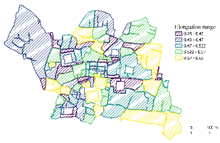 |
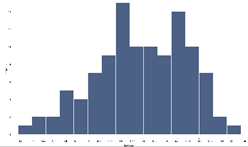 |
Mean: 0.495 Std.: 0.082 Min.: 0.28 Median: 0.494 Max.: 0.65 |
In 1912, a total of 110 blocks were analyzed for elongation. The elongation values ranged from 0.30 to 0.62, demonstrating a wide range of block elongation characteristics and reflecting diversity in block elongation. The mean value is 0.498, the median is 0.514, and the standard deviation of 0.071 indicates some variability. This diversity is confirmed by the relatively balanced distribution around the mean.
Table 8.
Distribution of the block elongation values in the 1912 map and their statistical parameters.
Table 8.
Distribution of the block elongation values in the 1912 map and their statistical parameters.
| Elongation rage | Distribution | Parameter |
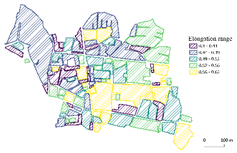 |
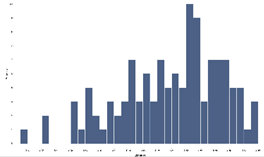 |
Mean: 0.498 Std.: 0.071 Min.: 0.30 Median: 0.514 Max.: 0.62 |
From the actual map, 84 blocks were analyzed for elongation value interpretation. The elongation values range from 0.19 to 0.65, indicating a very wide range of block elongation characteristics with several peaks, as reflected in the histogram. The standard deviation of 0.091, the highest among the three time periods, indicates significant variability in elongation values. This suggests a diverse nature of block dimensions in the actual data, reflecting transformation processes within the block scale.
Table 9.
Distribution of the block elongation values in the actual map and their statistical parameters.
Table 9.
Distribution of the block elongation values in the actual map and their statistical parameters.
| Elongation rage | Distribution | Parameter |
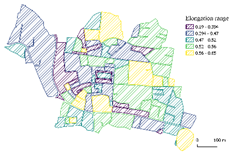 |
 |
Mean: 0.481 Std.: 0.091 Min.: 0.19 Median: 0.495 Max.: 0.65 |
Overall, the evolution of block elongation characteristics is significant, reflecting changes from a balanced distribution to a significant spread of values that collectively shaped the region’s overall spatial organization. The elongation values in 1885 reference the block dimensions in the cohesive urban fabric, which provided underlying uniformity. In contrast, the mix of consistent and varied elongation values in the 1912 layer reflects both the order of the earlier period and the beginning of a more diverse urban form, serving as a bridge between the Ottoman urban structure and contemporary urban formation.
4.3.2. Size (block Area)
The examination of block sizes, specifically their area and perimeter, aims to identify transformations of the geometric properties. By analysing these measurements, we can logically identify variations and consistencies. This analysis helps us understand how features adapt or respond to changes in block size, as transformations in elements do not occur uniformly. This non-uniformity represents variable behavior in the geometric properties of the blocks within an intermediate level of specificity detailed in the built morphological framework.
Table 10.
Spatial distribution of block area values over time and their statistical parameters.
| Spatial distribution of the block area - 1857 | Spatial distribution of the block area - 1912 | Spatial distribution of the block area - actual |
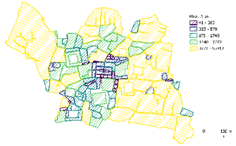 |
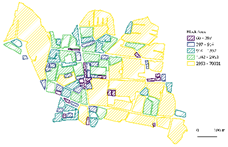 |
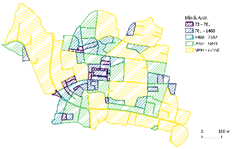 |
| Parameters | ||
| Mean: 3314.30 Std.: 6763.94 Min.: 41.24 Median: 1326.42 Max.: 55912.13 |
Mean: 2878.48 Std.: 7119.17 Min.: 60.18 Median: 1243.52 Max.: 70001.35 |
Mean: 4432.72 Std.: 8261.46 Min.: 73.10 Median: 1985.24 Max.: 67549.64 |
The distribution of the block area ranges from 41.24 m² to 55,912.13 m² in 1857. The mean area is significantly higher than the median, and most blocks have smaller areas, resulting in a right-skewed distribution. A few significantly larger blocks influence the mean and the standard deviation, which are considered outliers compared to the rest of the distribution. The high standard deviation also confirms the large variability in the block areas. A significant number of blocks are below 2,000 m², indicating that smaller blocks are common. The spatial distribution of these smaller blocks corresponds to marketplace concentration. The presence of some exceptionally larger blocks, mainly positioned around the Khan aggregate, pulls the mean values upwards.
Compared to 1912, the distribution is quite similar; there is substantial overlap in the block areas between the two years. Most block areas are clustered towards the lower end, but 1912 shows greater variability (a broader distribution) with more extreme values than 1857. This is because some small blocks in 1857 combined to create larger blocks in 1912. The distribution remains right-skewed over time, while the frequency of smaller blocks has decreased, and the presence of larger blocks has increased. This is evident in the rising standard deviation, indicating the highest variability among the three periods.
The block pattern size established during the initial formation was exposed to significant constraints, which were replaced within the patterns, resulting in transformations in urban tissue over time.
4.3.3. Points of Access (Number of Block Frontage)
At the block level, the investigation of access and block frontage establishes the internal orientation of the blocks (plots and buildings) and the arrangement that constitutes the urban tissue. Block fronts interface necessarily with a road segment in a way that geometrically associates buildings with access points, revealing the spatial structure of the urban fabric and their process of transformation over time.
The basic principle for identifying the point of access within the different types of frontage is as follows: the total count of points within each block boundary is associated with the shortest distance (line) between the road segments.
The concentration of points of access tends to be located at the periphery of the marketplace, which has higher active block frontage. This shaped the block and building fabric of the Khan region in 1857. Most likely, those areas represent the residential structure of the Ottoman fabric, where the roads were very narrow and buildings faced the street with a single facade. In the Ottoman era’s city order, the entrance of individual houses was directly connected to public spaces (one-step depth) and faced the street. However, in the current period, traditional block frontage patterns have almost been erased or transformed due to changes in land use or the occupation of parcels. This transformation is evident and correlates with changes or persistence in the geometric properties of the blocks.
Figure 6.
Number of access points per block and road segment integration with the shortest line for the periods 1857 and current.
Figure 6.
Number of access points per block and road segment integration with the shortest line for the periods 1857 and current.
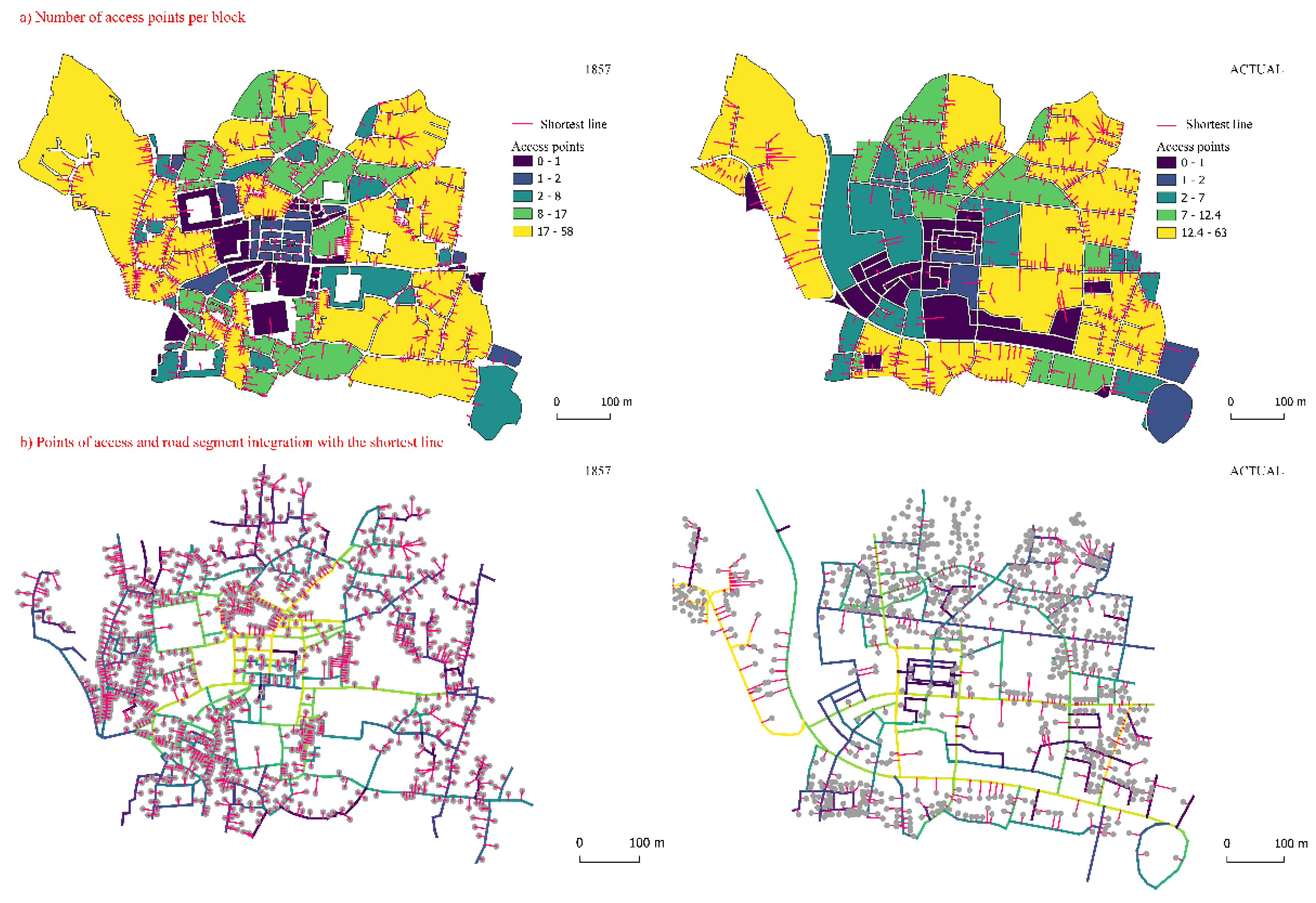
4.4. Buildings
Specific Type of Parts and Building Type per Block
The built fabric is the most tangible elements in the urban fabric, including their boundaries and locations. These elements outline the internal structure of blocks and streets that constitute the visible part of the urban tissue, which is the basic unit in the productive process of towns and cities. Evolutionary changes in building types, involving the details of the structure that emerge with development and innovation (cultural evolutionary processes), give rise to different parts of the whole.
The overall layout and arrangement of buildings (geographical distributions of past patterns) and structures within an urban area can give a sense of character, but monuments are unique features that distinguish one area from another [25]. The geographical position of buildings and their polygonal characteristics allow for the extraction of typological information, such as the orientation of a building within a block’s internal arrangement. This information can also characterize changes in the internal layout of the blocks over time, providing insights into how the internal structure evolves. By analysing these changes, we can understand the continuity and transformation of the internal structure over time.
The block types extracted from the 1857 block typologies were formed into 107 different shapes and sizes, while those from actual maps formed 85 different shapes and sizes, encompassing various block and building types (Figure 7). Irregular, trapezoidal, or rectangular block patterns generally surround the Khan marketplace during both periods. Monumental buildings appear to be shaped with blocks, but their complex structures within the same blocks should also be considered. This is why monumental buildings and their complexes often have irregular or polygonal patterns due to the varying positions and sizes of the buildings within the block over time.
Most irregular patterns, aside from monumental irregular block patterns, are bordered by multicourt yard or detached configurations in the current period, which enclose some empty corners of the irregular shapes. Both periods demonstrate consistency and a high frequency of irregular block patterns (75 in 1857, 33 currently), though building types within these blocks have evolved in different ways.
Each individual building pattern within all block combinations must be considered to identify the specific tangible patterns of selected heritage sites, as each combination could characterize different building patterns. This approach reveals the patterns and provides predictive information, offering the opportunity to discover historic character and hidden layers in contemporary heritage sites.
Although the variations of block patterns in heritage sites are not very diverse, blocks with the same characteristics may not always have the same typology. The diversity in variation is organic and influenced by the number of buildings, their positions, and other variables in building patterns. The monumental architectural patterns that make up the landmark’s typology integrate with the patterns of the built environment. Monumental blocks are generally surrounded by courtyard-type complex buildings, harmonizing with the surrounding courtyard-type typologies. While the purpose of the blocks remains somewhat consistent, the arrangement of the buildings has changed over time. Blocks surrounding the monumental blocks with multicourt yard building typologies have transformed into more regular typologies. The reduction in the variation of building types within the blocks reflects changes in the urban layout of the region.
4.5. Green Spaces
Size (Green Area)
To analyze the transformation of cities, it is significant to trace the changes in green areas throughout their growth. Examining the rates of change in urban green areas through different historical periods provides a deeper understanding of how the physical environment of modern urban areas has developed.
In many historically stratified cities, continuous green spaces are generally located adjacent to former physical limitations on urban growth, most notably surrounding city walls, a pattern characterized morphologically as fringe belts [51]. Urban green spaces within the inner parts of cities, often in historical cores, have changed in terms of their position and size over time.
In Bursa, a sizeable portion of the green areas in 1857 was located around the urban growth limit of the Khan region. The small green areas were fragmented from this inner green fringe belt to residential areas. In the present, the green areas have become more uniformly sized, which is evidence of the influence of urban transformation. Statistical results prove the regression in the sizes of green areas from 1857 to the present. The decrease in variability reflects that the sizes of green areas have become more consistent, though generally smaller over time.
The continuous survival of green areas surrounding the region indicates that none of the phases of change have created significant pressure on these areas. These continuous green areas are embedded in the urban fabric over time and are recognized as aspects of heritage.
Table 11.
Spatial distribution of block area values over time and their statistical parameters.
| Spatial distribution of the green areas - 1857 | Spatial distribution of the green areas - current |
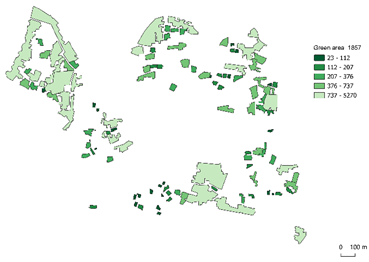 |
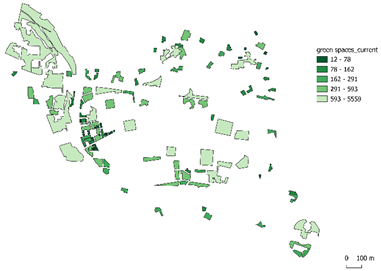 |
| Parameters | |
| Mean: 643.96 Std.: 1021.89 Min.: 23.14 Median: 264.14 Max.: 5269.72 |
Mean: 472.52 Std.: 811.89 Min.: 12.08 Median: 208.85 Max.: 5558.56 |
5. Results
5.1. Cluster Analysis
5.1.1. Classification by Morphological and Qualitative, and Quantitative Properties of the Morphological Unit Character
Clustering is based on the key results of character analysis, utilizing two variables—street type and street age—to re-evaluate morphological units both qualitatively and quantitatively. The four clusters identified by K-means clustering appear to be well-defined and reflect the palimpsest approach. To implement the proposed clustering method, label encoding was used to convert the categorical attributes of street type and street age into numerical values. This method aims to analyse these continuous variables in urban form, describe the characteristics of the morphological region, assess their spatial distribution over time, and evaluate their statistical distribution. (Figure 8) illustrates the spatial and statistical distribution of character areas within the measured clusters, categorizing four types of characters. (Table 12) presents the percentage distributions of values within the clusters.
Starting from the bottom right corner, Cluster 1 delineates the medieval thoroughfare and continuous loop patterns. This character tends to remain within the surroundings of the marketplace. The bottom left corner, Cluster 4, is the largest cluster with 129 features, showing a more diverse distribution of street types and street ages, and has similarities with Cluster 1. Cluster 3, located in the top right corner, is characterized by its predominantly medieval street age pattern (79.07%), a combination of thoroughfare routes, tree-like routes, and cul-de-sac routes, with a lower rate of later alterations in the region. The top left corner, Cluster 2, represents patterns of predominantly medieval street geometry (74.51% thoroughfare) with a soft transition to the modernization era. This includes a significant presence of district connector routes from the modernization of the city (type 1) at 19.61%.
5.1.2. Classification by Morphological and Qualitative, and Quantitative Properties of the Blocks Shape and Size
Shape and size is the fundamental characteristic in seeking to understand how and why forms take the shape they do. Identifying and classifying shape and size components is essential, as their transformation or formation involves geometric properties that vary over time. In examining urban form at the block level, the properties of these blocks elongation and blocks area may change as the voids in the urban form take shape over time and as occupancy patterns transform. Therefore, classifying blocks based on their elongation and area can reveal the diversity of species and spaces over time and block level changes detection. K-means can define clusters based primarily on the width/length ratio, effectively distinguishing different types of elongation and area. The five clusters identified by K-means clustering appear to be well-defined for elongation types.
Figure 9.
Spatial distribution of the K-means clustering results of the block elongation and block area values.
Figure 9.
Spatial distribution of the K-means clustering results of the block elongation and block area values.

The distribution of clusters in 1857 proves the orientation of the Khan areas and zonal differences, displaying well-identified specific block patterns of the Ottoman structure. By 1912, the clusters demonstrate reorganization and differences in distribution, evidencing significant changes in the urban layout. Between 1857 and 1912, Cluster 2 (C2) remained relatively stable in size and shape, while Clusters 1 (C1), 3 (C3), and 4 (C4) showed a decrease in size. Current clustering results indicate that the clusters have adapted to the 1912 urban layout structure, with an expansion of the clusters, and significant changes observed in (C2) since 1857. The K-means clustering represents the variation of block outline attributes with shape and size characteristics over time. It is an effective method for recognizing the spatial distribution of urban blocks and their structures.
5.1.3. Classification by Morphological and Qualitative, and Quantitative Properties of the Building Types
The method for classifying buildings involves hierarchical clustering of the results from K-means clustering at the block level, based on their conceptual morphological properties. This approach provides a level of specificity (typological similarity) in the classification.
The decision on the number of clusters requires several trials until the minimum cluster variances are merged into a single cluster. After several processes, at the block level, four internal arrangement clusters have been identified based on their building morphological variables. Five block clusters are classified into four levels of building type classification within different spatial distributions. To compare the distribution of value types between periods, descriptive statistical analysis is conducted to capture typological types that remained or changed.
According to the cluster results presented in (Figure 10) and typologies of the cluster over the time (Figure 11).
Cluster 1 (n=207) in 1857 and (n=176) currently, the multi-courtyard type remains consistent and reflects the most dominant type in the current period. However, there is a significant decrease in the detached type (from 128 to 16) and a noticeable increase in the courtyard type (from 2 to 18) over time, proving the shift towards more diverse building types.
Cluster 2 had (n=310) buildings in 1857, but currently, the number of buildings has decreased to (n=82) due to the shrinkage of the blocks over time. This reduction has significantly decreased both the number and diversity of building types (typology) within the cluster. However, two types – detached and multi-courtyard – have maintained their presence.
Cluster 3 had (n=242) buildings in 1857 and has increased to (n=363) buildings currently. The number of detached buildings has increased from 83 to 96, and the number of multi-courtyard buildings has risen from 74 to 176. This growth, along with the appearance of a new building type—semi-detached—has led to greater diversification of building types within the cluster. The multi-courtyard type still characterizes the typology of the cluster region.
Due to the decrease in size of Cluster 4 and Cluster 5 over time, the number of buildings has decreased from (n=250/181) in 1857 to (n=173/81) currently. Despite this reduction, the multi-courtyard buildings have maintained their significance. Throughout this period, Clusters has retained its typological character, dominated by multi-courtyard (95/77 in 1857 and 48/38 currently), and landmark buildings (72/43 in 1857 and 107/67 currently).
6. Discussion
This paper analyses the morphological, qualitative, and quantitative properties of urban morphology to interpret the transformation process in the urban form of Bursa, specifically the Khan urban heritage site. The differences in street age and street type in clusters where the landmarks are located show statistically similar patterns compared to the surrounding region, but they also display a more diverse distribution of patterns. This can be explained by several factors: the street network hierarchy is influenced by modernist planning practices, while the historic core has maintained its organic structure due to the preservation of the monuments layout, reflecting the persistence of the city’s basic layout and plans. Streets around the heritage surroundings are designated to have a high level of correlation to the subsystems, enhancing the configurational properties of the heritage sites in terms of street traffic volumes. This clearly illustrated the problems on the topological discontinuity is purely inherent.
Clustering results based on the blocks, considering their sizes and shapes, show statistically significant differentiation. This is related to the increased topological depth over time, resulting from the combination of different blocks to create contiguous block typologies. The block shapes are well-organized due to the transformation of medieval-age streets, with modifications making the block lines straighter. This has resulted in more compact spaces with the shrinking of block sizes over time, and the internal loads of blocks becoming more heterogeneous. These changes contribute to alterations in tissue boundaries, access, and the arrangement of elements, which affect the historical appearance of the environment. Undoubtedly, changes in block parameters are derived from practical reasons to make urban planning more effective and functional. This clearly illustrates that the problems with topological continuity are inherent and related to the syntactic transformation of the heritage site.
Through the hierarchical clustering analysis, significant trends and building patterns in the transformation process of building types were revealed. The stability of the multi-courtyard building types in each cluster is decisive in determining block typologies. These derivational practices of the multi-courtyard type reflect the modes of morphological existence in the urban fabric. However, the materials and functions of these buildings change over time and cannot remain the same. Conversely, the significant reduction in detached type buildings and the emergence of new semi-detached types undoubtedly reflect changes in block usage and social preferences.
7. Conclusions
This study examines the qualitative and quantitative properties of urban form at different scales in the case study of the Bursa Khan urban heritage site by utilizing cartographic maps and actual data. Layering principles of different maps form the basis of the study. Quantitative properties are derived from statistical analysis, while qualitative properties are assessed using a descriptive framework of urban morphology. This paper confirms that it is possible to rigorously identify similarities and differences between the abstract and dynamic pattern characteristics of urban form and their variation over time at different scales by combining descriptive and analytical approaches to urban morphology.
We examined seven primary character categories for morphological, qualitative, and quantitative analysis to address the main research question: how urban transformation be described in terms of changes in structural and numerical parameters. Our findings show that, based on clustering methods, it is possible to simplify changes in urban form, and measurable variables of urban form correlate with the spatio-temporal dimension of urban morphology. The clusters around monumental buildings, where the urban form is well-preserved, quantitatively show continuity in the urban fabric compatible with the urban transformation process. We also found that changes in topological parameters are related to changes in the numerical parameters of block characteristics, enabling new and unexpected urban development.
The findings prove the used the method is a rigorous approach to studying urban form. By combining descriptive and analytical frameworks of urban morphology, this method can be reproduced to identify historical stratification processes in different cities, enhancing our understanding of how cities evolve and stratify over time.
The integration of historical analysis with modern methodological approaches provides a holistic framework for addressing the complex challenges of urban transformation. In conclusion, the discipline of urban morphology remains crucial for understanding and directing the transformation of modern cities. The incorporation of new theoretical and methodological frameworks, as illustrated in the Bursa study, deepens our comprehension of urban complexities. By combining qualitative and quantitative approaches, urban morphology supplies tools for analyzing historical continuity and change, ensuring that urban spaces can fulfil contemporary needs while preserving their historical and cultural significance.
Author Contributions
Conceptualization, E.S. and E.L.; methodology, E.S.; software, E.S.; formal analysis, E.S.; investigation, E.S.; writing—original draft preparation E.S. and E.L.; writing—review and editing, E.S. and E.L.; visualization, E.S.; supervision, E.L. All authors have read and agreed to the published version of the manuscript.
Funding
This research received funding from the Tempus National Fund - Stipendium Hungaricum Programme, University of Debrecen University and National Library and individual funding from the Corresponding Author.
Data Availability Statement
Data are contained within the article.
Acknowledgments
The research was supported by the Hungarian Scientific Research Fund (Grant number: K_142121).
Conflicts of Interest
The authors declare no conflicts of interest.
References
- É. Lovra, ‘The Integrated Urban Morphology Method and the Urban Morphology Matrix’, presented at the 6th International conference Contemporary achievements in civil engineering, Subotica, Serbia, 2018, pp. 535–543.
- J. W. Whitehand, ‘The structure of urban landscapes: Strengthening research and practice’, Urban Morphol., vol. 13, no. 1, pp. 5–27, 2009. [CrossRef]
- Levy, ‘“Urban morphology and the problem of the modern urban fabric: some questions for research’, Urban Morphol., vol. 3, no. 2, pp. 79–85, 1999. [CrossRef]
- S. Türkoğlu, ‘Formation and transformation of urban fabric in the 19th century Bursa’, MS thesis, Middle East Technical University, 2002.
- M. Jia, Y. Liu, S. N. Lieske, and T. Chen, ‘A Fractal Approach to Explore Australian Urban Form and Its Impacting Factors at Neighbourhood Scale’, in The Mathematics of Urban Morphology, 2019, pp. 123–144.
- K. Kropf, ‘Urban tissue and the character of towns’, Urban Des. Int., vol. 1, no. 3, pp. 247–263, 1996.
- Alexander Christopher, A pattern language: towns, buildings, construction. Oxford, United Kingdom: Oxford university press, 1977.
- Alexander Christopher, The Timeless Way of Building, vol. 1. New york, NY: Oxford University Press, 1979.
- Caniggia G, Maffei GL, Composizione architettonica e tipologia edilizia 1. Lettura dell’edilizia di base. Marsilio, Venice, 1979.
- M. R. G. Conzen, Alnwick, Northumberland: A Study in Town-Plan Analysis, Second edition. Institute of British Geographers Publication 27, 1960. [CrossRef]
- Cullen, Gordon, Concise Townscape (1st ed.). Routledge, 1961. Available online: https://doi.org/10.4324/9780080502816 (accessed on 12 07 2024).
- Lynch, Kevin, The Image of the City. Cambridge, Massachusetts, United States of America: M I T Press, 1964.
- Lynch, Kevin, What time is this place. Cambridge, MA, USA: The MIT Press, 1972. [CrossRef]
- Muratori, S., S. Studi per una Operante Storia Urbana di Venezia I. Rome, Italy,: Libreria dello Stato, 1960.
- Rossi, The architecture of the city. MIT press, 1984.
- Genette, G., Palimpsests: Literature in the second degree. London: University of Nebraska, 1997.
- G. Genette, The Architext: An Introduction. University of California Press, 1992.
- P. J. Larkham, ‘Extending Urban Morphology: Drawing Together Quantitative and Qualitative Approaches’, in The Mathematics of Urban Morphology, 2019, pp. 503–515.
- V. Oliveira, Urban morphology: An introduction to the study of the physical form of cities. AG Switzerland: Springer International Publishing, 2016.
- Ünlü, Tolga, ‘Planning Practice and the Shaping of the Urban Pattern. In Teaching Urban Morphology’, in Teaching Urban Morphology, Cham, Switzerland: Springer International Publishing, 2018, pp. 31–49.
- M. Conzen, ‘Thinking about urban form: papers on urban morphology, 1932–1998′, Conzen MP., Peter Lang, Oxford, 2004.
- K. Kropf, ‘Aspects of urban form’, Urban morphology, vol. 13, no. 2, pp. 105–120, 2009.
- G. Strappa, ‘Reading the built environment as a design method’, in Teaching urban morphology, Cham, Switzerland: Springer International Publishing, 2018, pp. 159–184.
- K. Kropf, ‘Ambiguity in the definition of built form’, Urban Morphol., vol. 18, no. 1, pp. 41–57, 2014. [CrossRef]
- K. Kropf, The Handbook of Urban Morphology, First Edition. John Wiley & Sons Ltd., 2017.
- É. Lovra, ‘Urban tissue typology and urban typology (1868-1918)’, Prostor, vol. 24, no. 2, pp. 202–215, 2016.
- L. D’Acci, ‘On urban morphology and mathematics.’, in The mathematics of urban morphology, Cham, Switzerland: Springer International Publishing, 2019, pp. 1–18.
- M. Batty, The new science of cities. Cambridge, MA, USA: MIT Press, 2013.
- M. Batty and P. A. Longley, Fractal cities: a geometry of form and function. Cambridge, MA, USA: Academic Press, 1994.
- Hillier and J. Hanson, The social logic of space. Cambridge: Cambridge University Press, 1984.
- Hillier, Space is the Machine: a configurational theory of architecture. Cambridge: Cambridge University Press, 1996.
- S. Marshall and Y. Gong, ‘Urban pattern specification’, Institute of Community Studies, London, 23, 2005.
- S. Marshall, Streets and patterns. Routledge, 2004.
- J. Dibble et al., ‘Urban Morphometrics: Towards a Science of Urban Evolution’, arXiv preprint arXiv:1506.04875, 2015.
- Venerandi et al., ‘Form and urban change–An urban morphometric study of five gentrified neighbourhoods in London’, Environ. Plan. B Urban Anal. City Sci., vol. 44, no. 6, pp. 1056–1076, 2017. [CrossRef]
- Vialard, ‘A typology of block-faces’, PhD Thesis, Georgia Institute of Technology, 2013.
- QGIS.org, ‘QGIS Geographic Information System’. 2024. Available online: http://qgis.org (accessed on 01 06 2024).
- Salt Research, Harika-Kemali Söylemezoğlu Archive, ‘Harika-Kemali Söylemezoğlu Archive. Bursa Şehri Harita Mufassalası’, 2013. Available online: https://archives.saltresearch.org/handle/123456789/122041 (accessed on 01 06 2024).
- Salt Research, Harika-Kemali Söylemezoğlu Archive, ‘Harika-Kemali Söylemezoğlu Archive. Official City Map of Brousse (Bursa) (Scale 1:8000)’, 2013. Available online: https://archives.saltresearch.org/handle/123456789/111021 (accessed on 01 06 2024).
- OSM, ‘OpenStreetMap contributors’. 2015. Available online: https://www.openstreetmap.org (accessed on 01 06 2024).
- M. P. Conzen, ‘Core Concepts in Town-Plan Analysis’, in Teaching Urban Morphology, V. Oliveira, Ed., in The Urban Book Series. , Springer, 2018, pp. 123–143.
- M. Municipality, ‘Bursa (Khans Area & Sultan Social Complexes) And Cumalikizik World Heritage Site Management Plan (2021-2026)’. 2021. Available online: https://shorturl.at/mwS36 (accessed on 01 06 2024).
- Pancaroglu, ‘ARCHITECTURE, LANDSCAPE, AND PATRONAGE IN BURSA: The Making of an Ottoman Capital City’, Assoc. Bull., vol. 19, no. 2, 1995. Available online: https://about.jstor.org/terms (accessed on 12 07 2024).
- M. Municipality, ‘Bursa (Khans Area & Sultan Social Complexes) And Cumalikizik World Heritage Site Management Plan (2013-2018)’. 2013. [Online]. Available: https://shorturl.at/duHV4.
- M. A. Arat, ‘Strengthening the Conzenian method of morphological regionalization’, PhD Thesis, Faculdade de Engenharia da Universidade do Porto, 2022.
- P. Osmond, ‘The urban structural unit: towards a descriptive framework to support urban analysis and planning’, Urban Morphol., vol. 14, no. 1, pp. 5–20, 2010. [CrossRef]
- S. Griffiths and L. Vaughan, ‘Mapping spatial cultures: contributions of space syntax to research in the urban history of the nineteenth-century city’, Urban Hist., vol. 47, no. 3, pp. 488–511, 2020. [CrossRef]
- J. Lang, Urban design: the American experience. John Wiley & Sons, 1994.
- Van Nes and C. Yamu, Introduction to Space Syntax in Urban Studies. Springer, 2021.
- S. Marshall, Y. Gong, and N. Green, ‘Urban compactness: New geometric interpretations and indicators’, in The mathematics of urban morphology, Cham, Switzerland: Springer International Publishing, 2019, pp. 431–456.
- J. W. R. Whitehand, ‘Green space in urban morphology: a historico-geographical approach’, Urban Morphol., vol. 23, no. 2, pp. 5–17, 2019. [CrossRef]
Figure 1.
The four steps research framework.
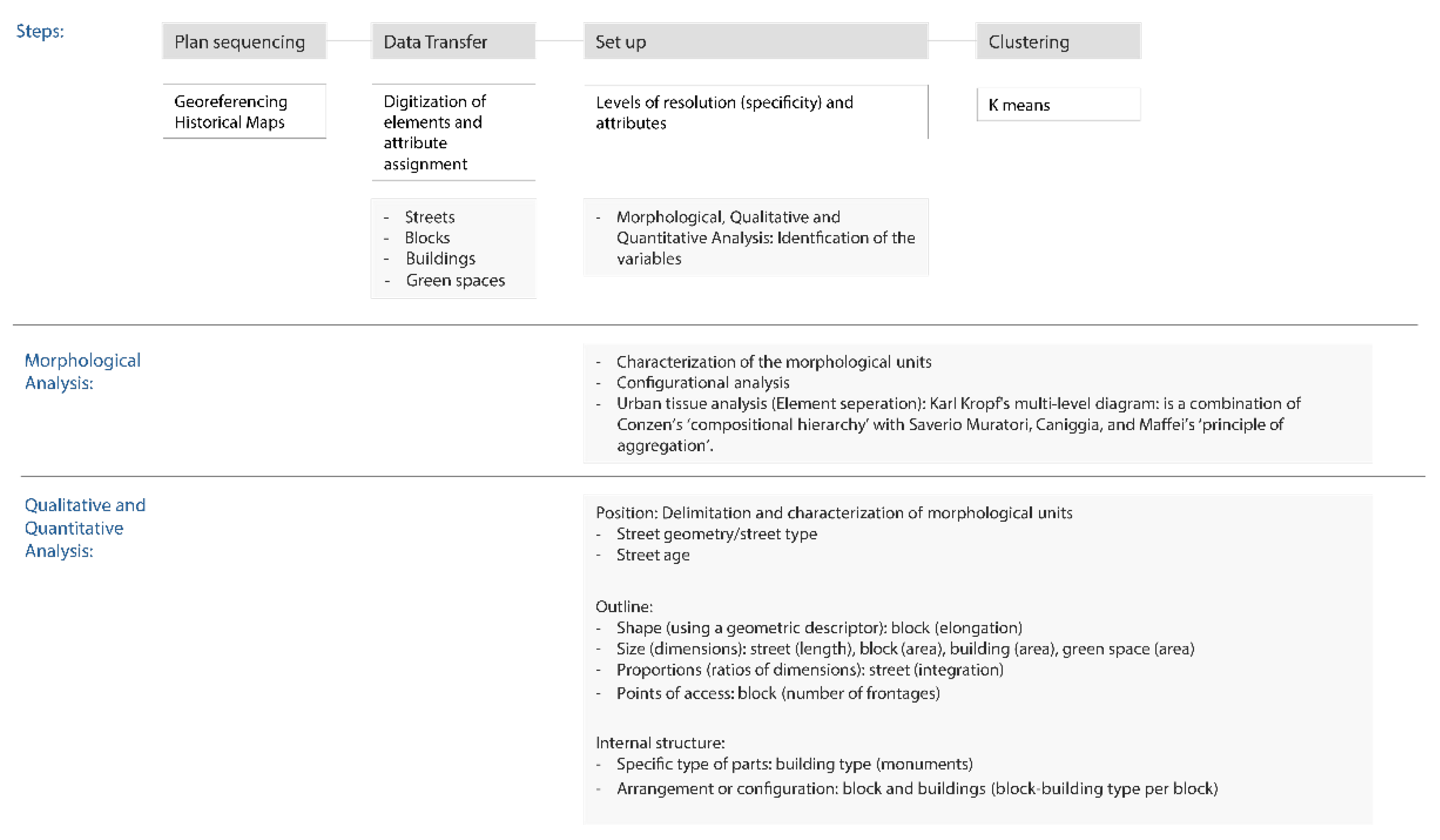
Figure 2.
Representation of the geographical position of the selected city and case study site (a), the boundary in black, street layout and blocks layout in blue (b), and buildings patterns and registered buildings in grey (c).
Figure 2.
Representation of the geographical position of the selected city and case study site (a), the boundary in black, street layout and blocks layout in blue (b), and buildings patterns and registered buildings in grey (c).
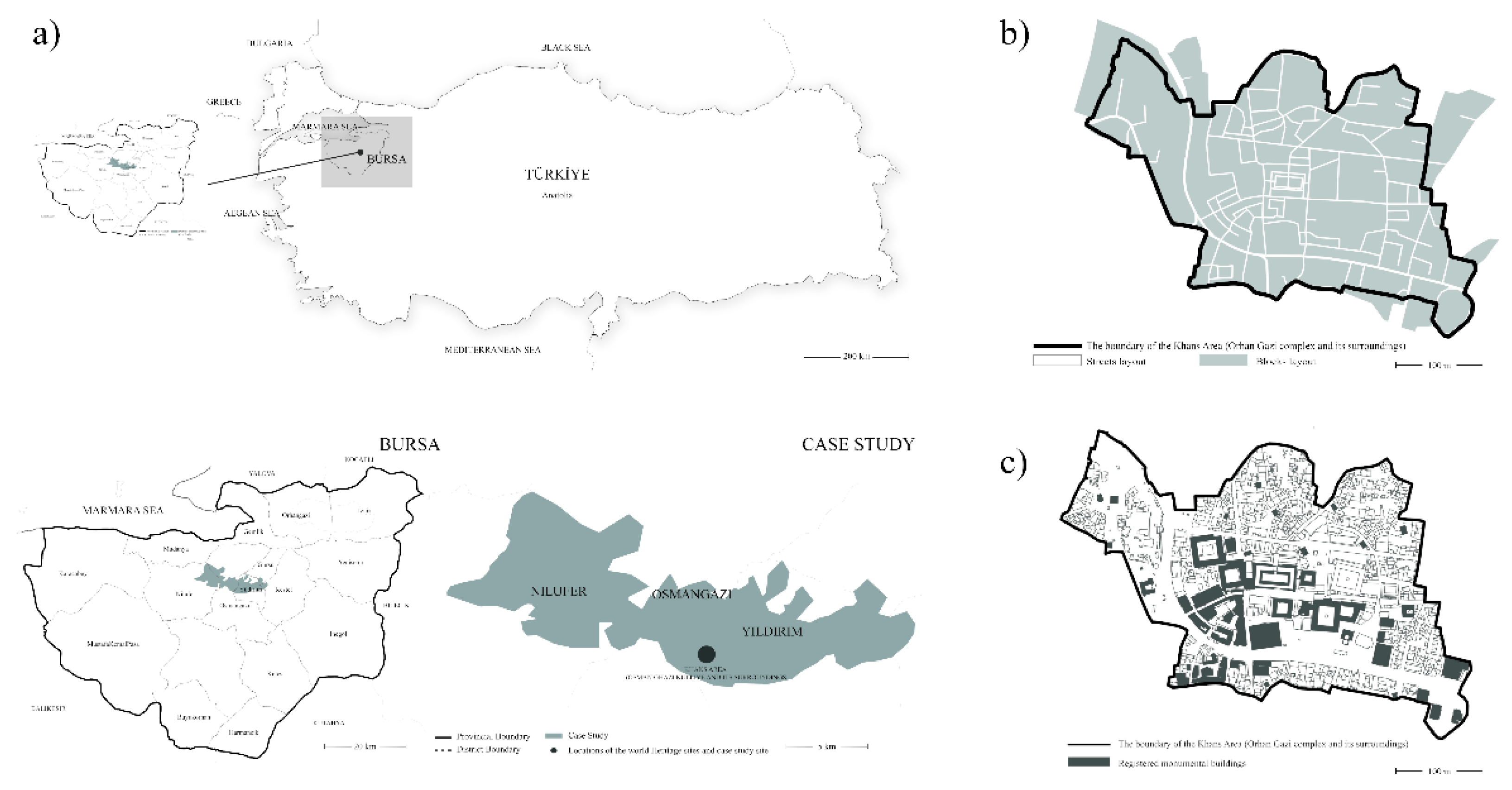
Figure 3.
Evolution of street ages in the Khan aggregate over time, revealing the categorization of street geometry based on Marshall’s framework.
Figure 3.
Evolution of street ages in the Khan aggregate over time, revealing the categorization of street geometry based on Marshall’s framework.

Figure 4.
Evolution of the morphological region coverage of the Khan area over time, with its elements: streets, blocks, and building footprints.
Figure 4.
Evolution of the morphological region coverage of the Khan area over time, with its elements: streets, blocks, and building footprints.
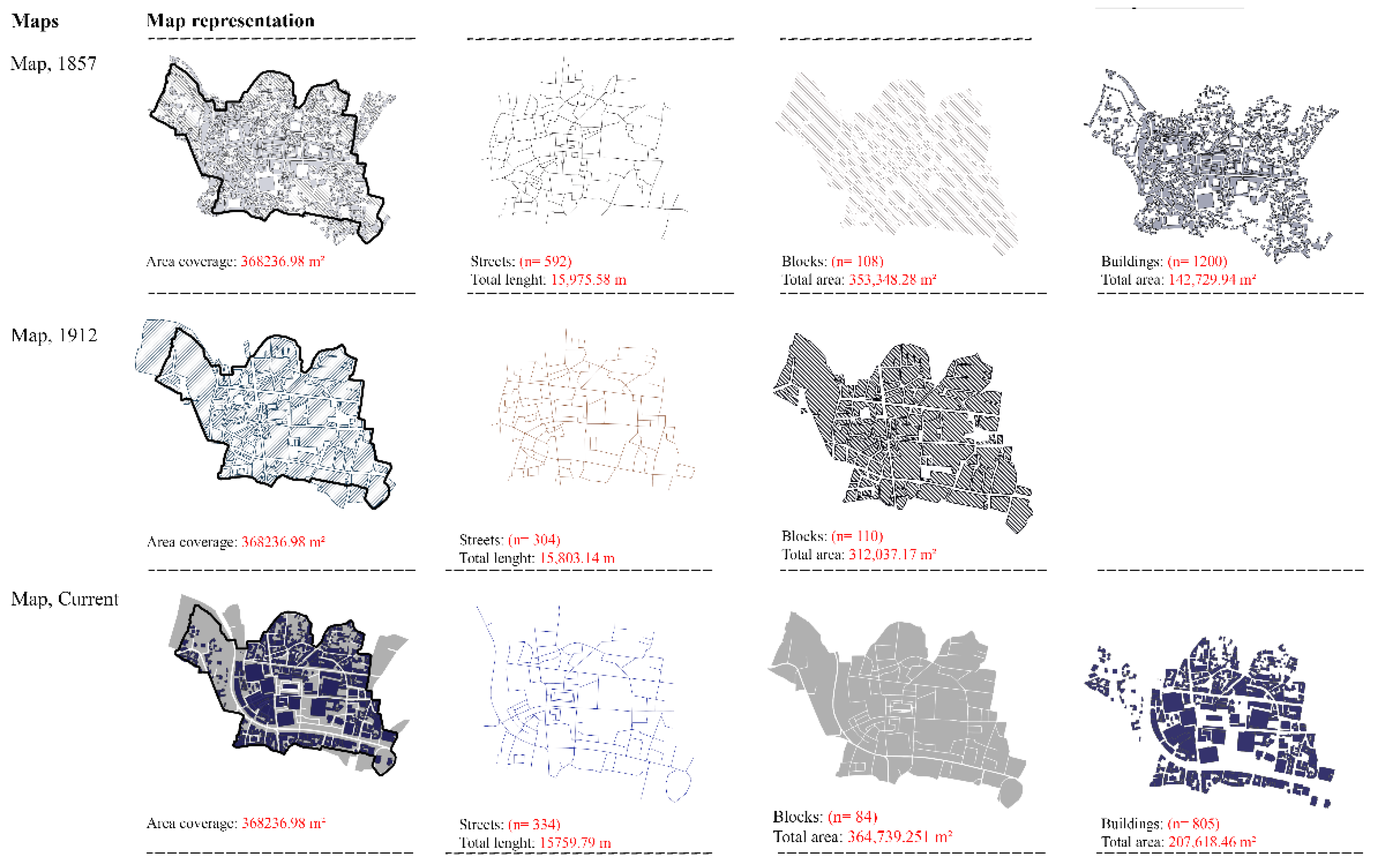
Figure 7.
The maps of the typologies of the blocks and building types.
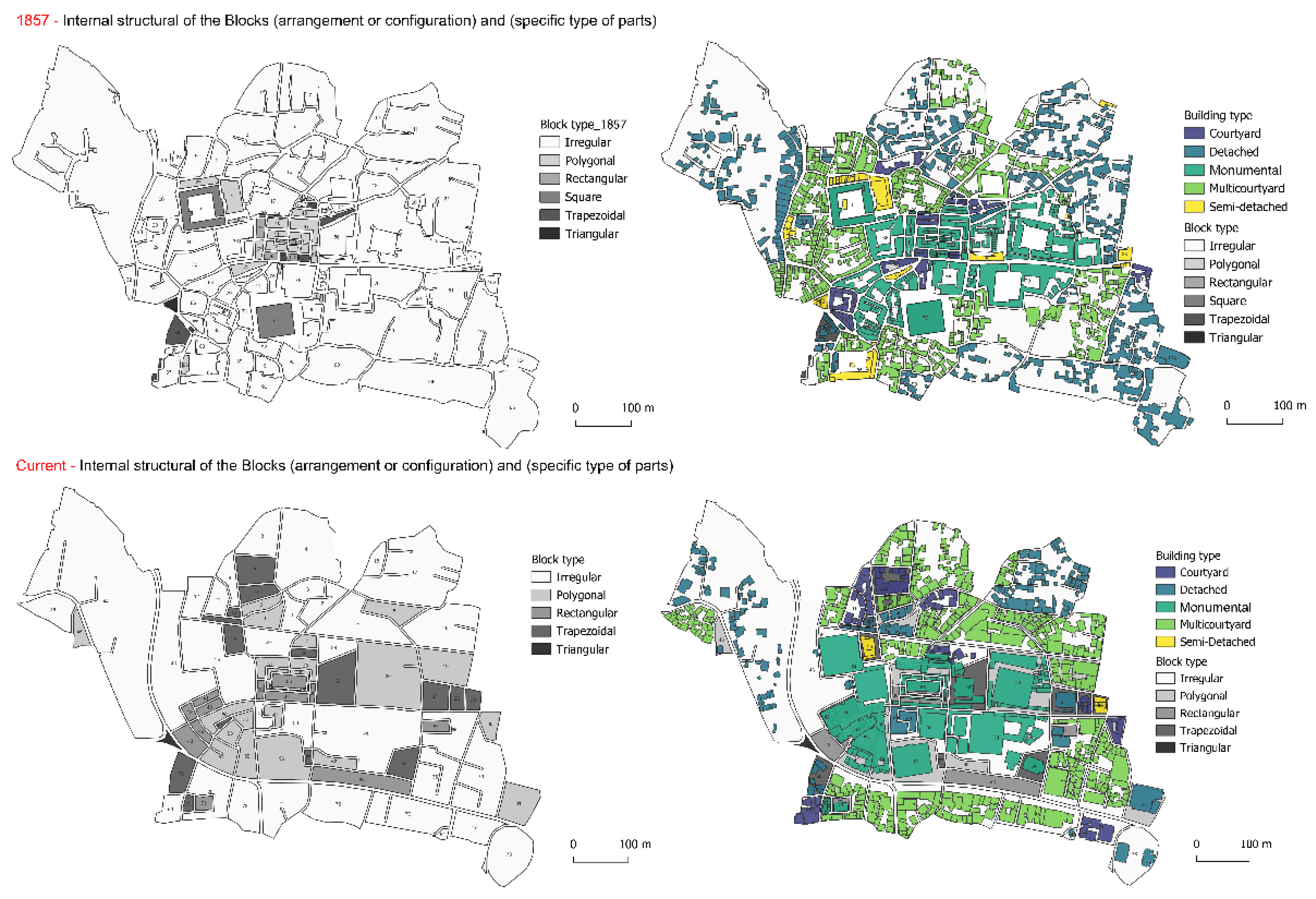
Figure 8.
Spatial and statistical distribution of the K-means clustering results of the street age, and street type values.
Figure 8.
Spatial and statistical distribution of the K-means clustering results of the street age, and street type values.
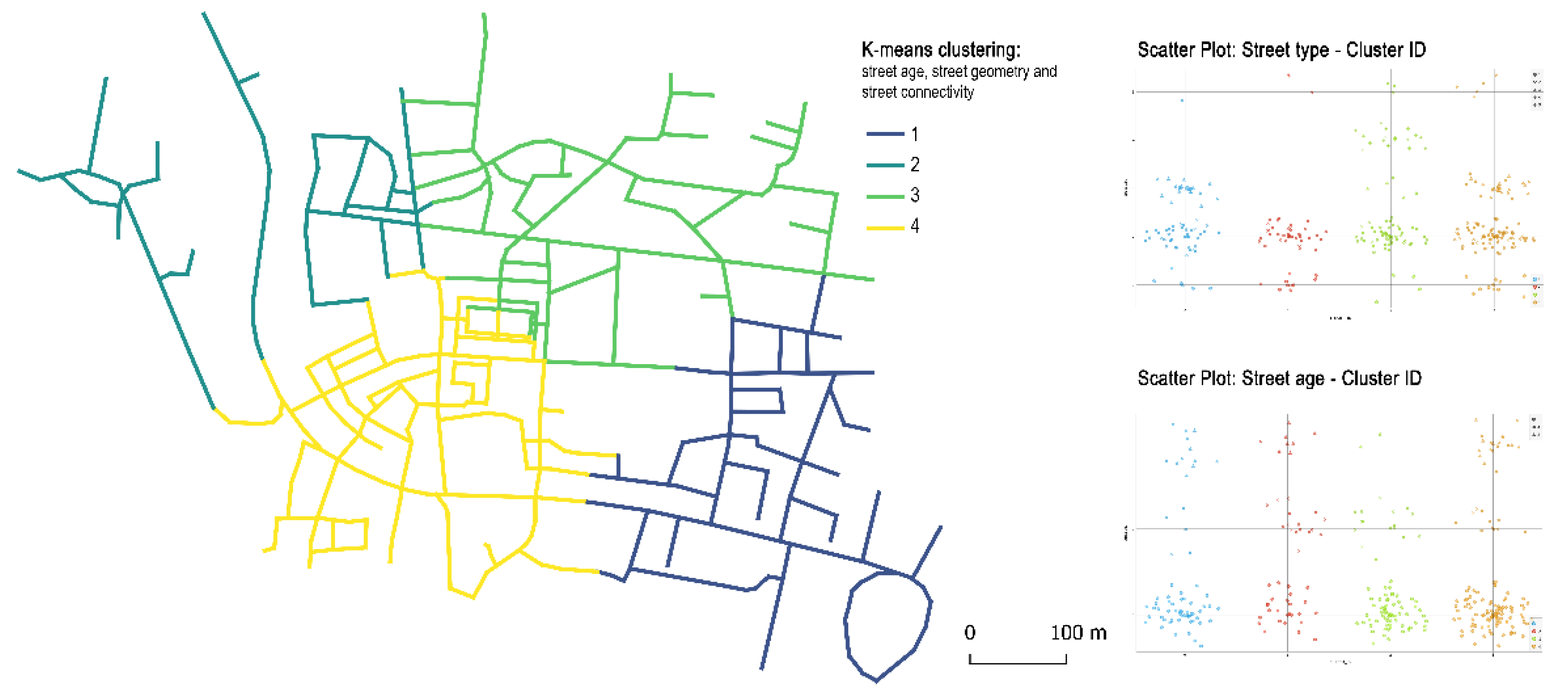
Figure 10.
Spatial distribution of the hierarchical clustering results of the building types.
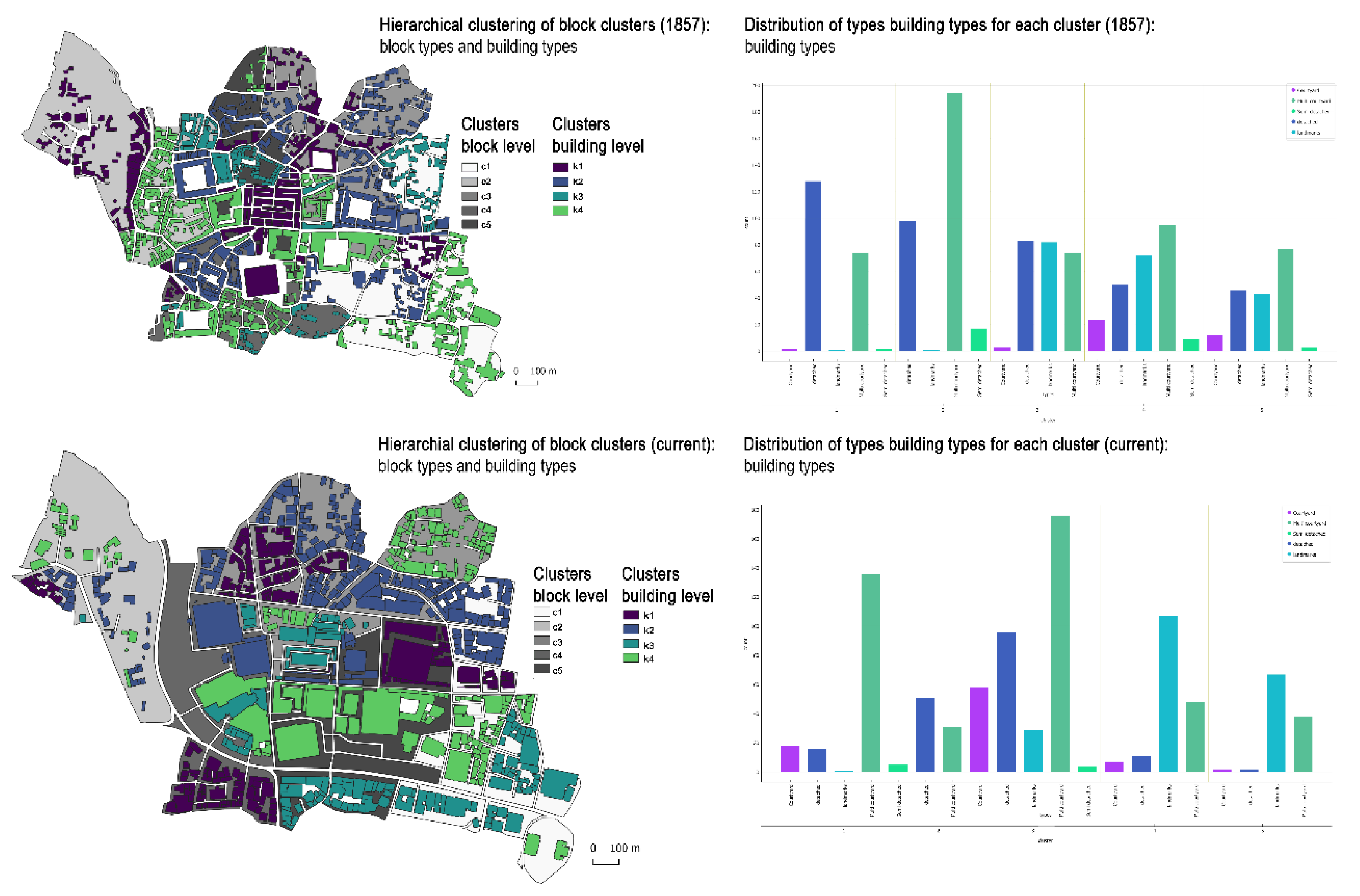
Figure 11.
Typologies of the clusters and their variation over time.
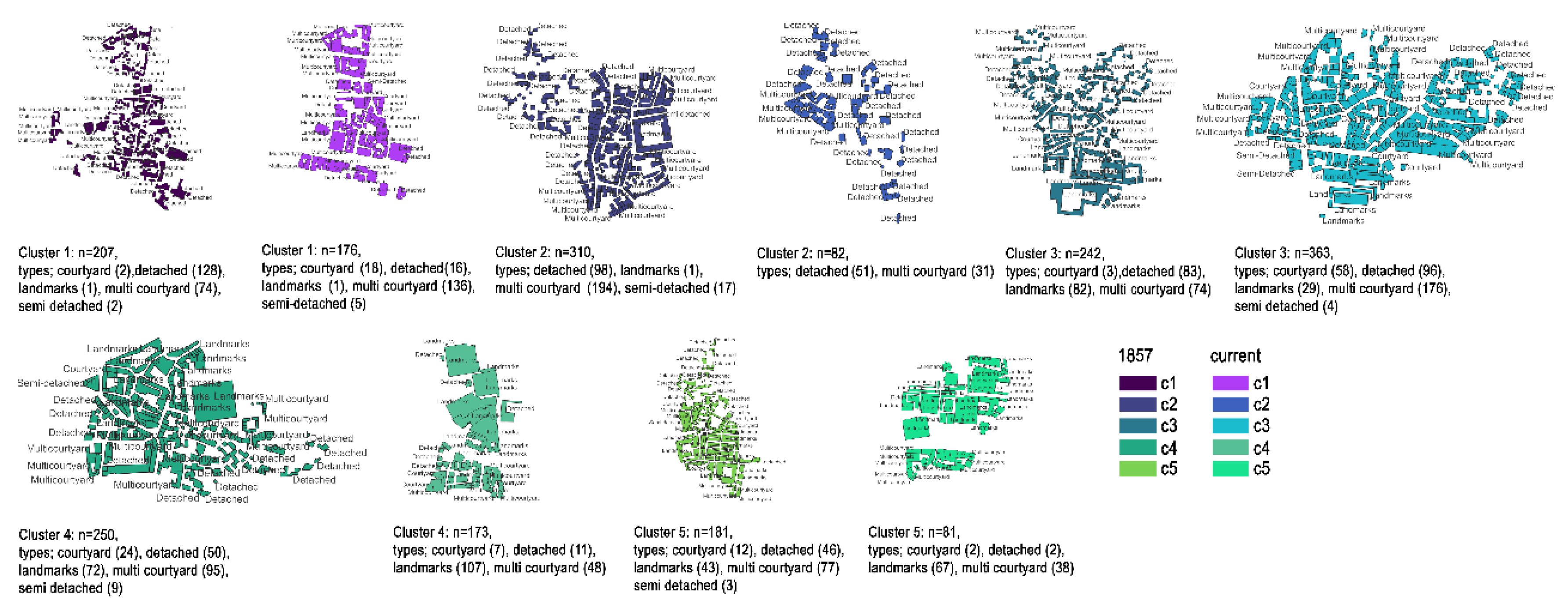
Table 1.
Categories of character and metrics used for the element separation analysis.
| Principles | Category of character | Levels | Character variables (qualitative and quantitative) | Unit of measure |
| Position | Morphological unit | (1) | Street type | |
| (1) | Street age | |||
| Outline | Shape | (3) | Block elongation | [42,44] |
| Size | (1) (2) (3) (5) |
Coverage Street segment length Block area Green area |
[n], [m2] [m] [m2] [m2] |
|
| Proportions | (2) | Street integration | [n] | |
| Points of access | (3) | Number of block frontages | [n] | |
| Internal structure | Specific type of parts | (4) | Building type (monuments) | |
| Arrangement or configuration | (3) (4) | Block-Building type per block |
Table 2.
Summary of morphological region, percentage of blocks area coverage and buildings area coverage.
Table 2.
Summary of morphological region, percentage of blocks area coverage and buildings area coverage.
| Map Period | Total Land Area (m²) | Total Block Area (m²) | Block Area Coverage (%) | Total Building Area (m²) | Building Area Coverage (%) |
| Map, 1857 | 368,326.98 | 353,348.28 | 95.93% | 142,729.94 | 38.75% |
| Map, 1912 | 368,326.98 | 312,037.17 | 84.72% | ||
| Map, Current | 368,326.98 | 364,739.251 | 99.03% | 172,956.04 | 46.96% |
Table 4.
Distribution and angular segment integration analysis of the 1857 map with their key statistical parameters.
Table 4.
Distribution and angular segment integration analysis of the 1857 map with their key statistical parameters.
| Angular segment integration analysis | Distribution | Parameter |
 |
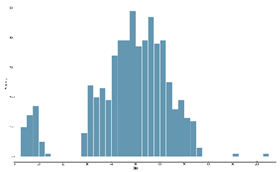 |
Mean: 47.84 |
| Std.: 16.28 | ||
| Min.: 3.64 | ||
| Median: 49.75 | ||
| Max.: 104.73 |
Table 5.
Distribution and angular segment integration analysis of the 1912 map with their key statistical parameters.
Table 5.
Distribution and angular segment integration analysis of the 1912 map with their key statistical parameters.
| Angular segment integration analysis | Distribution | Parameter |
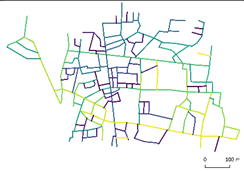 |
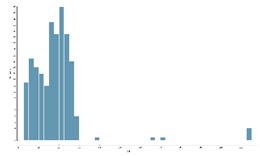 |
Mean: 18.28 |
| Std.: 13.71 | ||
| Min.: 2.75 | ||
| Median: 17.77 | ||
| Max.: 113.78 |
Table 6.
Distribution and angular segment integration analysis of the actual map with their key statistical parameters.
Table 6.
Distribution and angular segment integration analysis of the actual map with their key statistical parameters.
| Angular segment integration analysis | Distribution | Parameter |
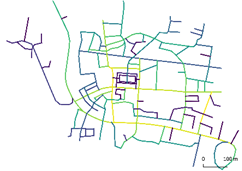 |
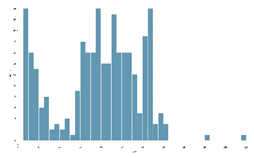 |
Mean: 38.76 |
| Std.: 19.83 | ||
| Min.: 2.69 | ||
| Median: 40.73 | ||
| Max.: 109.71 |
Table 12.
The percentage distributions of the street types and street ages within each cluster.
| Cluster ID | 1 | 2 | 3 | 4 |
| Street Type (%) 1: District distributor |
8.82 | 19.61 | 4.65 | 8.53 |
| Street Type (%) 2: Thoroughfare |
57.35 | 74.51 | 66.28 |
66.67 |
| Street Type (%) 3: Through loop |
32.35 | 0.00 | 5.81 |
20.93 |
| Street Type (%) 4: Tree-like and cul-de-sac |
0.00 | 0.00 | 19.77 | 0.00 |
| Street Type (%) 5: End loop |
1.47 | 5.88 | 3.49 | 3.88 |
| Street Age (%) 1: Medieval street layout |
75.00 | 52.94 | 79.07 | 76.74 |
| Street Age (%) 2: Beginning of the 20th century (modernization of the city) |
7.35 | 31.37 | 18.60 | 8.53 |
| Street Age (%) 3: Later alteration |
17.65 | 15.69 | 2.33 | 14.73 |
Disclaimer/Publisher’s Note: The statements, opinions and data contained in all publications are solely those of the individual author(s) and contributor(s) and not of MDPI and/or the editor(s). MDPI and/or the editor(s) disclaim responsibility for any injury to people or property resulting from any ideas, methods, instructions or products referred to in the content. |
© 2024 by the authors. Licensee MDPI, Basel, Switzerland. This article is an open access article distributed under the terms and conditions of the Creative Commons Attribution (CC BY) license (http://creativecommons.org/licenses/by/4.0/).
Copyright: This open access article is published under a Creative Commons CC BY 4.0 license, which permit the free download, distribution, and reuse, provided that the author and preprint are cited in any reuse.
MDPI Initiatives
Important Links
© 2024 MDPI (Basel, Switzerland) unless otherwise stated







